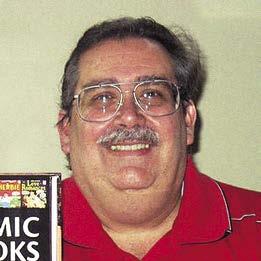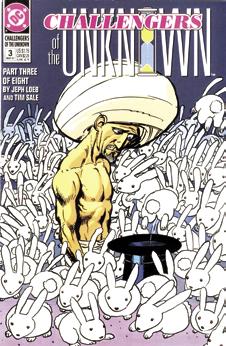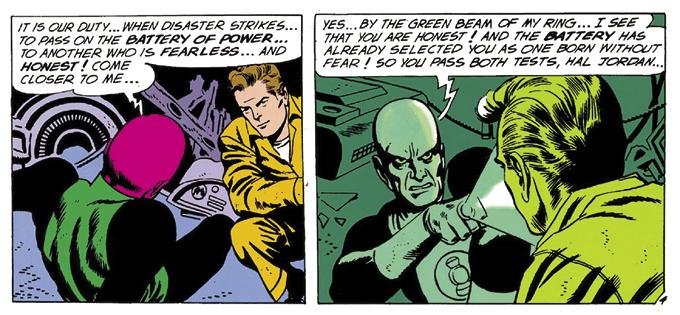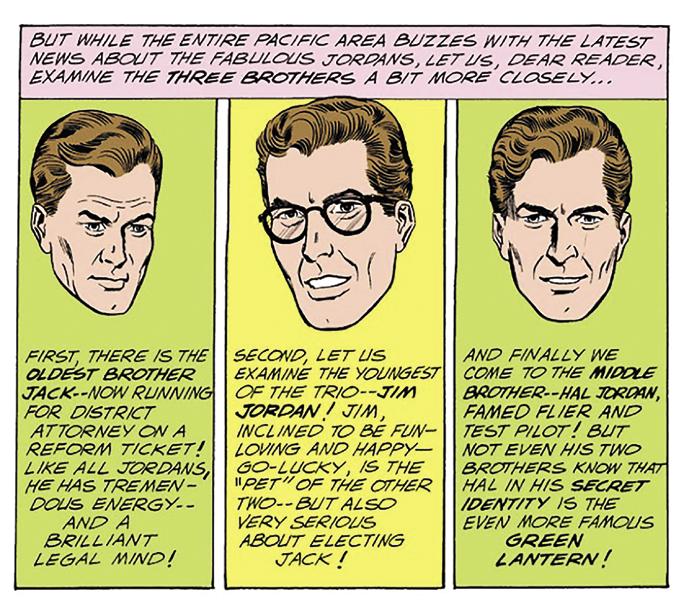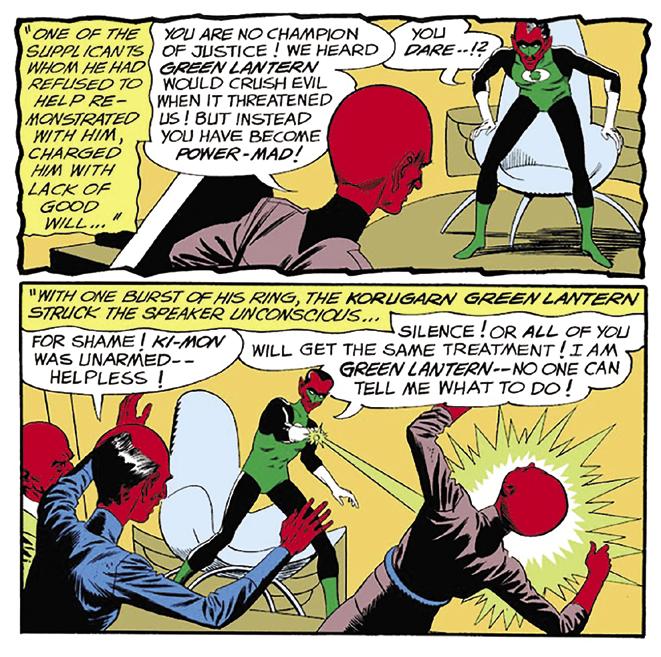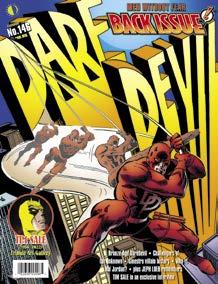


September 2023
EDITOR-IN-CHIEF
Michael Eury
PUBLISHER
John Morrow
DESIGNER
Rich Fowlks
COVER ARTIST
Gene Colan
(Originally produced for the 1978 Mighty Marvel Pin-up Book.
Art scan courtesy of Heritage Comic Auctions.)
COVER COLORIST
Glenn Whitmore
COVER DESIGNER
Michael Kronenberg
PROOFREADER
David Baldy
SPECIAL THANKS
Jeff Bailey
Jarrod Buttery
Ed Catto
Chris Claremont
Gerry Conway
Rocky Davis
J. M. DeMatteis
Chuck Dixon
Steve Englehart

Steven Grant
Jack C. Harris
Heritage Comics Auctions
Tony Isabella
James Heath Lantz
Jeph Loeb
Ed Lute
Brian Martin
Marvel Comics
Prof. Larry Maslon
Luigi Novi
Tom Powers
Jerry Riddle
Bob Rozakis
John Siuntres
Bryan D. Stroud
Roy Thomas
J. C. Vaughn
Marv Wolfman
Don’t STEAL our Digital Editions!
C’mon citizen, DO THE RIGHT
THING! A Mom & Pop publisher like us needs every sale just to survive! DON’T DOWNLOAD OR READ ILLEGAL COPIES ONLINE! Buy affordable, legal downloads only at www.twomorrows.com or through our Apple and Google Apps!
& DON’T SHARE THEM WITH FRIENDS OR POST THEM ONLINE. Help us keep producing great publications like this one!
Daredevil in the 1970s
The Man without Fear swings through the Bronze Age. Plus: The Torpedo!
STUFF: Gene Colan
BACK ISSUE™ issue 146, September 2023 (ISSN 1932-6904) is published monthly (except Jan., March, May, and Nov.) by TwoMorrows Publishing, 10407 Bedfordtown Drive, Raleigh, NC 27614, USA. Phone: (919) 449-0344. Periodicals postage paid at Raleigh, NC. POSTMASTER: Send address changes to Back Issue , c/o TwoMorrows, 10407 Bedfordtown Drive, Raleigh, NC 27614
Michael Eury, Editor-in-Chief. John Morrow, Publisher. Editorial Office: BACK ISSUE, c/o Michael Eury, Editorin-Chief, 112 Fairmount Way, New Bern, NC 28562. Email: euryman@gmail.com. Eight-issue subscriptions: $97 Economy US, $147 International, $39 Digital. Please send subscription orders and funds to TwoMorrows, NOT to the editorial office. Cover artwork by Gene Colan. Daredevil TM & © Marvel. All Rights Reserved. All editorial matter © 2023 TwoMorrows and Michael Eury. Printed in China. FIRST PRINTING
On his always-informative website, Marvel Executive Editor Tom Brevoort informs us that—in the 1960s, riding high on the success of Fantastic Four Amazing Spider-Man —Marvel’s publisher Martin Goodman instructed writer/editor Stan Lee to create “a knock-off of FF and a knock-off of Spider-Man” for Marvel to publish. These projects became and Daredevil, respectively—with Avengers #1 (Sept. 1963) rushed into production to fill the gap when Daredevil fell behind.
DAREDEVIL IN THE ’60s

Artist Bill Everett and Lee create athlete and academic Matthew (Matt) Murdock in Daredevil #1 (Apr. 1964). As a high school student, Matt saves the life of a blind man by pushing him out of the way of an out-of-control truck. The truck crashes and something radioactive strikes Matt in the face. Matt is blinded but finds that his other senses have been enhanced to peak capacity—plus he has developed a built-in “radar sense.”

Matt graduates from high school, then as valedictorian from law school. He opens a law firm with his best buddy Franklin “Foggy” Nelson, and they hire Karen Page as their secretary. But when Matt’s boxer father is murdered by crooked fight arranger, the Fixer, Matt uses his enhanced senses and athletic abilities to step outside of the law as the costumed crimefighter, Daredevil!
Stan wrote the first 50 issues of Daredevil introducing adversaries such as the Owl, the Purple Man, Mr Fear, Stilt-Man, the Ani-Men, Gladiator, Exterminator, Jester, and more. 1960s’ soap-opera themes also ran high: Matt loved Karen but dared not tell her because he was blind; Karen loved Matt and wished he felt the same (which he did); Foggy loved Karen but knew Karen loved Matt, and thus Foggy both resented Matt and resented himself for resenting his best friend. One could be forgiven for thinking that one was reading Our Love Story


Interestingly, one experiment highlighted Matt’s desperate attempt to protect his secret identity by pretending to be his own heretofore-unmentioned identical twin brother, Mike. Y’see, Foggy and Karen believe that they have found proof that Matt is Daredevil. On the spot, Matt tells them that his brother Mike is really Daredevil! And so, in issue #25 (Feb. 1967), Matt wears sunglasses, musses up his hair, dons some garish clothes, and speaks like a hipster stereotype—all to convince his friends that his previously unmentioned identical twin brother is actually Daredevil.
It was a temporary experiment. A battle with the Exterminator in Daredevil #41 (June 1968) leads to a laboratory explosion. The Exterminator is thrown into an extra-dimensional void and scraps are found of Daredevil’s costume, in a story titled: “The Death of Mike Murdock!” (Fortunately, as Matt explains in the following issue, Mike had been secretly training a replacement Daredevil.)
Bit by bit, developments occurred. Foggy ran for District Attorney (and won). He started dating (and later married) Debbie Harris. Matt and Karen grew closer…
However, heightened abilities or not, Stan couldn’t write everything forever, and so turned over Daredevil’s scripting duties to Roy Thomas with issue #51 (Apr. 1969). Thomas has Daredevil meet the Black Panther for the first time in issue #52, followed by a retelling and expansion of Daredevil’s origin in issue #53, specifically placing Matt’s teenage accident as having occurred in 1950.

Thomas gives Karen Page a backstory in Daredevil #56 (Sept. 1969). Karen is the daughter of disgraced scientist, Dr. Paxton Page—who perfected the cobalt bomb, and then refused to divulge the results of his research to Congress. Karen travels to her family home in Vermont. When Daredevil follows, they are confronted by a skeletal horseman calling himself Death’s-Head, who claims to have killed Karen’s father! However, Daredevil determines that Death’s-Head is Karen’s father—driven insane by years of exposure to cobalt radiation. There is a fight, Karen is endangered, and Death’s-Head sacrifices himself to save his daughter. At her father’s funeral, Matt reveals his identity to Karen.
Matt and Karen become engaged in Daredevil #58 (Nov. 1969)—an issue that introduces the motorcycling menace Stunt-Master—but Karen immediately starts fretting over the danger that Matt exposes himself to as Daredevil. This continues into the following issue as DD faces hired killer, the Torpedo.
DAREDEVIL IN THE ’70s
Matt loses more points as he forgets Karen’s birthday while fighting Jester, Cobra, and Mr. Hyde in Daredevil #61 (Feb. 1970). Finally, in issue #63, Karen quits her job as secretary and announces that she has a plane to catch. Matt wants to stop her, and Karen wants Matt to stop her, but Matt is delayed battling the Gladiator—and Karen boards her flight to Los Angeles. Roy Thomas explains: “I felt Karen had been underdeveloped… not much more than having a crush on Matt Murdock... so I decided to do more with her. That escalated once I had Matt reveal his identity to her, some thing I’m sure I cleared with Stan first.”
Matt flies to L.A. and creepily breaks into the apartment of Karen’s friend Sally Weston. He discovers that Karen is working as an actress on the gothic-horror soap opera
Strange Secrets . There is an on-set killing, and Daredevil is forced to solve the murder-mystery while battling the super-strong Brother Brimstone. Thomas was cheekily asked if he was a fan of the gothichorror soap opera, Dark Shadows. “Yes, that was the inspiration for Brother Brimstone and that whole sequence. When I was working at home, the office (except for Stan, of course) had orders not to call me between 4:00 and 4:30, I think it was… the half-hour that Dark Shadows was on.”
Karen has found her calling. After years as a lovesick secretary, she had now found an engaging and rewarding career. In Daredevil #67 (Aug. 1970) she is offered a TV pilot with Stunt-Master and declines
to return to New York with Matt.
Daredevil helps a young boxer in issue #68 and re-teams with the Black Panther in issue #69. Thomas’ final storyline, in Daredevil #70–71 (Nov.–Dec. 1970), introduces Buck Ralston, an influential actor who aims to Make America Great Again by using his fame and wealth to legitimize his alter ego—the Tribune—to dispense justice to all the radical, subversive, pinko, commie pawns whom he believed were ruining the country. Rereading those issues, it’s sobering to see how little the propaganda machine has changed. Thomas opines, “Nope, things haven’t changed… including that the left has proved equally adroit at seeking to dispense justice to all the radical-right, subversive, fascist, white supremacist pawns.”

Gerry Conway succeeded Thomas as scripter with Daredevil #72 (Jan. 1971). Conway kindly
The Original Torpedo
The Man without Fear met a killer for hire named Torpedo—no relation to the hero spotlighted elsewhere in this feature—in Daredevil #59 (Dec. 1969). Cover by Gene Colan and Syd Shores.
The introduction of Natasha to the book was definitely in Conway’s plan: “I had written a couple of the Black Widow stories in Amazing Adventures and fell in love with the character. I actually really, really liked Roy’s interpretation of her, because he was doing a kind of Modesty Blaise take on her, and I thought that would be useful. I don’t remember if Roy suggested it, or I suggested it, but her initial appearance was more of a story beat in the Daredevil comic. Then when I saw how well they worked together—or maybe when Roy saw it—we said, ‘Hey, let’s put her in regularly!’ Daredevil wasn’t selling as well as it should have, or as well as some of the other books, so bringing in another superhero—to make it Daredevil and Black Widow —I think had a marketing twist to it, but there was a big creative aspect to it, too.
“Gene, of course, loved drawing beautiful women—so that was one very strong indicator to bring Black Widow into the book—in addition to the fact that I thought she would make a great ally of Daredevil’s and give the book some balance in the romantic department. Because the way that Karen Page had been played for the previous decade was this endless cycle of raising hopes and having them crushed, and delusions and misapprehensions… there wasn’t that much going on. And I didn’t have the inventiveness to realize that what I needed to do was address Karen by giving her more strength as a character, to make her an equal to Matt Murdock as a player in the series—but I knew that something had to change.
“Stan was a very good writer in a lot of ways, but he never was able to inhabit a female perspective,” Conway states. “The fact alone that he put emphasis on female characters—introducing them as members of superpowered groups—is to his credit. But his stuff was always the True Romance, lonely hearts, longing-for-what-she-does-not-have to complete-her-as-a-woman. It was so basic, it was useless as a template for characters. I mean, that’s one reason why I wrote Gwen Stacy out of Amazing Spider-Man because I literally could not see any future for her as a character. And that again is a limitation on my part because look what’s happened to her in the hands of other writers who’ve taken it in a different direction. Be that as it may, given the times and the situations, you look at Stan’s deficiencies and you try to address them to the extent that you can.
“The Karen Page of the Daredevil TV series would’ve been a terrific character to write. She was every bit as interesting as the other characters on that show—because she had her own agenda, she had her own set of skills, and she had her own position in the group that did not need them. I mean, she needed them in a crisis, but she didn’t need them to complete her. And, to my mind, that’s what Black Widow brought to the Daredevil comic. She clearly did not need Matt Murdock. She was completely fine on her own. She was more of an equal partner.”
FLOWERS IN THEIR HAIR
Daredevil #87 (May 1972) opens with Matt and Natasha moving into a house that Natasha has bought in San Francisco. Just as our heroes (and the series) start a totally new life, they have to face the very first supervillain that Daredevil ever fought: Electro.

The West Coast was definitely another of Conway’s ideas: “What ended up happening was I had visited California for about a month in… I guess it was 1971 or ’72… and I was staying in Los Angeles. A friend of Denny O’Neil was living in Haight Ashbury, and I thought it would be neat to visit San Francisco. I asked if I could stay at the guy’s house, and he said sure—and I loved the city! I’d seen it in movies but to actually be there with the view was pretty spectacular, and I took tons of photos. When I came back I had this idea, ‘What if we moved Daredevil to San Francisco?’ Where he would be basically the only superhero in town and we could focus stories around that. It would get him out of some of the lamer aspects of his civilian
Hey, Boris, It’s Natasha!
Recently seen in her own feature in Amazing Adventures, the Black Widow webbed herself to the pages of Daredevil as the hero’s partner in issue #81 (Nov. 1971). Original cover art by Gil Kane and Frank Giacoia. Courtesy of Heritage.

lackeys, but Matt’s sight throws off his other senses— he cannot operate as Daredevil—and so he asks Moondragon to reverse the process. Even so, it takes the assistance of guest-star Captain Marvel (and Angar) to defeat Broderick’s bunch in issue #107 (Jan. 1974). This issue’s letters page announces that the book is being demoted to bimonthly. Clearly, changes were to be made.

Daredevil #108 (Mar. 1974) had Black Widow absent from the masthead. The story is placed a couple of months after the previous issue. Moondragon is staying at Natasha’s house and things are tense. As Daredevil and Natasha foil a mugging, Natasha repeatedly beats a man who bashed an elderly lady—until Matt slaps Natasha. They return home and argue, but as Matt hears a news report about Foggy being in critical condition after being shot, he prepares to return to New York. Natasha refuses to accompany him.

Moondragon gives Matt a lift to New York in her spaceship. During the trip, she reveals that—through her telepathy—she is aware that Matt is strongly attracted to her, and she him, but it can never be. She returns to space as Matt rushes to his friend’s hospital room. There, he meets Foggy’s parents and sister, Candace, as well as Debbie. Foggy mumbles “Black Spectre” before passing out.

Here was Gerber’s multi-title crossover (and apparent attempt to increase sales). Black Spectre is a criminal organization dedicated to anarchy and the overthrow of the government. Its leader is Mandrill, who was created by Carole Seuling and Ross Andru in Shanna the She-Devil #4 (June 1973). Gerber scripted that issue, as well as Shanna #5 (Aug. 1973), where he introduced Mandrill’s partner, Nekra.
SHANNA THE SHE-DEVIL
Mandrill is a mutant who excretes pheromones allowing him to control women. Also a mutant, Nekra’s strength and invulnerability increase with her violent emotions. Together, they formed Black Spectre, using an army of armored, mind-controlled women. In Daredevil #109 (May 1974), Nekra defeats Black Widow in San Francisco, while Shanna arrives in New York.
Daredevil teams with the Thing in Marvel Two-in-One #3 (May 1974), on the trail of Black Spectre, where they find that Black Widow has been entranced to their cause! The Silver Samurai debuts in Daredevil #111 (July 1974) and kidnaps Shanna because she is the only woman capable of resisting Mandrill’s control.
Black Spectre storms the White House in Daredevil #112 (Aug. 1974), and Mandrill makes his way to the Oval Office. (The Avengers and FF dare not intervene because Mandrill has threatened to detonate an atomic bomb.) However, Daredevil is able to snap Natasha out of Mandrill’s control. They free Shanna, and the three heroes reclaim the White House.
Nekra is captured, but Mandrill escapes. The saga must have generated interest because Daredevil returns to monthly publication.
A change of pace occurs in Daredevil #113 (Sept. 1974). As Matt stays in New York, Shanna leaves, and Natasha returns to San Francisco. Candace Nelson (who has been flirting with Matt for the past few issues) is kidnapped by the Gladiator. Candace is studying at the School of Journalism and she discovered the “Sallis
You feel a pounding in your chest as your heart races, sweat rolls down your brow, your breathing is labored, and finally, your head starts spinning. You are in the grip of fear.
Daredevil doesn’t experience these feelings. Or does he? Although known throughout the Marvel Universe as the Man without Fear, Daredevil has experienced these feelings and more when he faced off against Mr. Fear!
Come along on a fear-fraught journey with BACK ISSUE as we look at the various evildoers who have taken on the fright-filled mantle of Mr. Fear!
ZOLTAN DRAGO
With a hero that’s known as the Man without Fear, it was a no-brainer to come up with a villain that inspired fear. That’s what writer Stan Lee and artist Wally Wood did when they introduced Mr. Fear as one of ol’ Hornhead’s earliest adversaries in Daredevil #6 (Feb. 1965). In fact, this was so early in Daredevil’s crimefighting career that he still wore his original yellow togs! He donned his iconic red outfit in the next issue.
Zoltan Drago was the first person to take on the guise of Mr. Fear. Drago used a gas pellet fired from a gun to implant fear into his victims. He accidentally stumbled across the formula for the gas when, as the owner of a wax museum, he attempted to make a formula that would bring his wax statues to life so that he could use them to rob banks. When he realized that his gas instilled fear in people, he created the Mr. Fear persona.
In this issue, Drago didn’t work alone, though, allying himself with two Spider-Man foes: Ox and the Eel. They didn’t come along of their own free will; Drago used his gas to terrorize them into joining him on his criminal campaign. He christened this association “The Fellowship of Fear.”
Wood’s costume design for Mr. Fear was outstanding: a modified skull mask with a colorful purple and pink costume that doesn’t sound like it should work, but it does. It even pops off the page and stands as an excellent design that others would emulate [see sidebar].
Daredevil was able to use his wits to defeat Mr. Fear by pushing the reverse button on a fan so that the fear gas would blow harmlessly away from him. While both Ox and the Eel would continue to have a presence in the Marvel Universe, Drago, as well the Fellowship, was done for. However, this wasn’t the last the Daredevil would hear of Mr. Fear.
Be Afraid
Gil Kane’s terrifying, vertigo-triggering cover art to Daredevil #91 (Sept. 1972) clued in readers that Mr. Fear was no pushover.

Mr. Fear returned to terrorize the Man without Fear in Daredevil #54 (July 1969). In the issue, written by Roy Thomas with pencils by Gene Colan and inks by George Klein, the villain challenged Daredevil to a showdown so that he could show New York City what a coward their hero was.

This time, Mr. Fear had an upgraded arsenal as he arrived on scene using a flying platform. Daredevil and Mr. Fear battled evenly for a time until Mr. Fear used his gas to incapacitate the hero. DD, who had been hanging onto the platform, fell off due to the fear-induced paralysis.
The next issue picked up with DD despondent because Mr. Fear’s pronouncement from the previous issue came true as people saw Daredevil as a coward. The hero also saw himself in the same light.

Never one to give in easily, the Man without Fear searched for ways to defeat the villain. During his search, he found that the original Mr. Fear, Zoltan Drago, was afraid of heights, so he deduced that Drago couldn’t be the person behind the Mr. Fear mask. Further research found that Drago had been killed in prison.

Armed with this new knowledge, Daredevil faced off against Mr. Fear again and exposed him as Samuel “Starr” Saxon. Shortly after being unmasked, the villain fell to his death.
The Fellowship of Fear!
(top left) Zoltan Drago, a.k.a. Mr. Fear, and his hulking henchmen mix it up with ol’ Hornhead in Daredevil #6 (Feb. 1965), illustrated by the wonderful Wallace Wood. (top right) Wood’s preliminary sketches for Mr. Fear and other characters in the issue. Courtesy of Ed Lute.

“Go forward.”
“I never think about losing.”
“I’m looking for hope.”
– Christopher Reeve
– Lou Ferrigno
– Professor Charles Francis Xavier, X-Men movie (2000)
Perhaps these quotes, more than any others, best describe the everyday lives of persons with disabilities in the face of all their challenges with activities the supposedly able bodied take for granted. Walking to a comic shop, seeing a page, hearing someone discuss the latest issue of Superman, or even talking about how a movie series such as X-Men may vary from the source material can be a daunting task for those who need assistance to move, look, listen, or speak.
However, characters such as X-mentor Professor Xavier, the Doom Patrol’s Niles Caulder, Teen Titan Joseph Wilson, Daredevil Matt Murdock, and Batgirlturned-Oracle Barbara Gordon are among the comicbook heroes that broke through their own physical barriers to inspire readers dealing with the trials and tribulations that they also endure in their lives in an age that wasn’t as inclusive as it is today.
BACK ISSUE #146 takes a look at the battles these superheroes went through in the Bronze Age, be those battles superhuman or the most mundane.
REPRESENTATION IN THE BRONZE AGE
One of the many things that attracts people of all ages, races, creeds, and sexual orientations to comic books and other forms of media is character identification. Outside of comics in 1981, Bill Bixby and Lou Ferrigno brilliantly portrayed both Dr. David Banner and the Hulk’s struggles with paralysis in the powerful Season Four episode of The Incredible Hulk titled “The Harder They Fall,” showing children and adults who dealt with the same issues that they were not alone. Ferrigno himself had battled hearing loss for most of his life before his recent cochlear implant surgery. Superman actor Christopher Reeve made us believe he could still fly in the real world after the horseback-riding accident created trials in his life to rival those of the Man of Steel. Comic-book superheroes have also shown readers that they are just like them in many ways in spite of having superhuman abilities, and that they, like Reeve, go forward to face whatever confronts them.
One thing all the characters named above have in common is that, unlike Maya Lopez/Echo from
First and Fearless
Golden Age hero Dr. Mid-Nite fought crime despite his blindness and blazed a trail for other superheroes with disabilities to follow. Undated portrait by Matt Wagner. Original art scan courtesy of Heritage Comic Auctions (www.ha.com).

Super Friends
Movie Superman Christopher Reeve advocated for people with spinal-cord injuries after a horseback-riding accident left him paralyzed. Television Hulk Lou Ferrigno overcame a profound hearing loss to become a successful bodybuilder and actor. Images courtesy of Heritage.


the Marvel Knights Daredevil series, and Slingers member the Hornet, they were not born with their disabilities. Some incident or injury caused their physical challenges, and thus, they had to adapt in ways that may be different from those who had started their lives not knowing what it’s like to walk, speak, see or hear. Young Matt Murdock, for example, not only struggled with blindness, he had to also cope with his remaining senses’ amplification assaulting him with a cacophony of sounds, tastes, and sensations that he had never felt with such intensity. Charles Xavier was a gifted athlete and dancer before his battle with the villain Lucifer caused his spinal injury. Niles Caulder was a brilliant inventor even before an explosion cost him the ability to walk. Young Joseph Wilson was an accomplished singer and musician before the Jackal cut his throat, rendering him mute. Barbara Gordon was a librarian that moonlighted as Batgirl until she was paralyzed by a bullet fired by the Joker. There was a period of adjustment for these superheroes. The same can be said for anyone who loses sight, hearing, or the ability to speak or move due to illness or injury. The characters mentioned above, and even Reeve and Ferrigno themselves, demonstrated to fans with disabilities that they fought the same battles as those who looked up to them. This helped readers believe that if such things could happen to heroes in the comic-book pages and/or actors who played them, they weren’t as alone as they maybe first thought.
Chris Claremont’s quote for BACK ISSUE speaks perfectly of how he handles Charles Xavier and other superheroes with disabilities:

Daredevil’s Heightened Senses
(top) From Stan Lee and Bill Everett’s Daredevil #1, Matt Murdock discovers his other senses have been enhanced since losing his sight. (bottom) Jeph Loeb and Tim Sale show the neo-hero’s amplified hearing in Daredevil: Yellow #5. (inset) Occasionally Matt’s blindness would inspire a story, such as What If? #8 (Apr. 1978). Cover by Gil Kane and Klaus Janson.


You would have thought they had the perfect recipe for success: Amazing adventures! Unlimited expense accounts! The King of Comics—as creator!
Yet despite all that, somehow DC Comics’ Challengers of the Unknown (also COTU or Challengers) fell short. Instead of triumphantly strutting off stage when their time had come, they tepidly returned onstage, and then returned again and again, always just missing the mark. How did Challengers of the Unknown ever get into this predicament?
Professor Larry Maslon, of New York University’s Tisch School of the Arts, suggests there’s a magic to be found in hero teams. “Fans and readers love adventure teams,” says Professor Maslon. “When they’re done right, it’s the ultimate narrative expression of the whole being greater than the sum of its parts.

“But they have to be the right parts. Alexandre Dumas understood this when he created the Three Musketeers in 1844. You had the nominal leader, Athos, surly and troubled; then the pompous braggart, Porthos; then the amorous aesthete Aramis. What they needed was the addition of a younger, less jaded, and courageous companion to make the team jell; hence, D’Artagnan. The four of them together (four being the magic number, I suppose) were narrative magic—their individual idiosyncrasies complemented each other beautifully—and their adventures are still beloved today, after a thousand different venues and versions.
“Such effective action/adventure teams found their way into the comics of the 1940s, some more superheroic, such as the Justice Society of America; some less so, like the Blackhawks. (The Blackhawks always struck me as effortfully idiosyncratic—I don’t know how Hendrickson even squeezed into his uniform—and early on, the Justice Society members fought their adventures separately.). By the time Jack Kirby created the Challengers of the Unknown in 1957, the comic-buying public was ready for a new team that combined the complementary team members of the pulp world but packed into the colorful leotards of the emerging superheroes of the Silver Age.” [Editor’s note: The Challs were created in late 1956 and premiered in Showcase #6, cover-dated Jan.–Feb. 1957.]

According to Maslon, “It’s surprising to me, though, that Kirby (I’ll leave it to you to parse out
‘A Plague of Darkness,’ Indeed!
As the Bronze Age began, Challengers of the Unknown fumbled to find its audience, looking more like a mystery than an adventure comic. Cover to issue #72 (Feb.–Mar. 1970) by Neal Adams.

THE ‘FIRST’ FINAL DAYS OF THE CHALLENGERS
After four tryout appearances in Showcase (issues #6 and 7, and #11 and 12), a regular, bimonthly series for the adventure team began with Challengers of the Unknown #1 (Feb.–Mar. 1958). The series continued until issue #77 (Dec. 1970–Jan. 1971).

Future comics pro Tony Isabella had several fan letters printed in Challengers during the last few years of the original series’ run.
Tony remembers his history with the title and why he liked them. “I started reading the series shortly after Jack Kirby left,” Isabella recalls. “In retrospect, the Challengers were like a grown-up version of the several kid gangs he did with Joe Simon. I dig the individuality of Ace, Rocky, Red, and Prof. I was really taken by the rugged art of Bob Brown. And what kid of my generation wouldn’t love the weird aliens, monsters, and villains?”
Isabella understands how the series tried to adapt to keep up with the times. “The series didn’t really start changing until DC Comics recognized Marvel Comics had become a force. Brown got a little wilder in his layouts. The writers threw in more ‘teen slang’ that many of them didn’t understand. Soap-opera elements like the ‘death’ of Red and the introduction of his kid brother began to impact some stories. There was a notable crossover team-up with the Doom Patrol, a team that was very much in the Marvel sensibility.”
Marvel-style romance was also a part of the new recipe baked into the Challengers series. Corrina Stark was a mysterious woman who was recently introduced into the series when her father shot Challs member Prof.

It was unclear if Challengers fans accepted Corinna’s addition to the team or not. A few excerpts from issue #78’s “Let’s Chat with the Challs” letters column reveal varied reactions:
“I’m madly in love with Corinna,” wrote reader Jim Williams. “Frankly, I’d love to come to New York to meet her, but the subsequent jolt of actually seeing her would turn me into a vegetable.” On the other hand, reader Mike Jeffries snapped, “Take that girl out!” D. A. Evans had a surprising suggestion: “Why don’t you add another girl, besides Corinna? Rocky’s sure to tumble for a cute, dark-haired, dark-eyed lass.”
The series really started swerving all over the road. Challengers took an occult turn, especially as Corinna’s newfound psychic abilities. Spooky covers and creepy story elements became the norm.
You’re a Rich Girl Challs hanger-on
Corrina Stark, from the conclusion of COTU #72. Written by Denny O’Neil, with art by Dick Dillin and Frank Giacoia. Scan courtesy of Ed Catto.
The first Challs issue of the Bronze Age, Challengers of the Unknown #72 (Jan.–Feb. 1970), kicked off things in style with a stunning Neal Adams cover. Evocative of Adams’ beautiful Tomahawk covers published during this time, an array of flashlights illuminates the characters with a warm yellow glow. And a menacing black cat has just scratched Corinna Stark… and it may be fatal! Beginning with issue #66, the comic’s logo had been reoriented to emphasize “Unknown” more than “Challengers of” [probably an attempt to cash in on the newfound popularity of mystery comics—ed.].
Denny O’Neil continues to pull out the stops, although it’s less effective than his Batman and Green Lantern/Green Arrow stories. Perhaps if his frequent partner and Challengers cover artist, Neal Adams, had collaborated it would have been different. Instead, Dick Dillin and Frank Giacoia illustrate this issue. The letters column does trumpet the coming of artist George Tuska the very next issue, although his participation would unknowingly be brief.
The premise of the story is almost prescient, as it deals with a virus that can be easily spread. And Walking Dead–style, it essentially turns people into zombies. Ace realizes that everyone will be affected “unless we can quarantine those already affected and locate the source.”
Despite the scientific basis of it all, Corinna drags the conversation back to the occult.
“For years, while I was imprisoned in my father’s castle, I studied the occult. I learned that black magic does exist, but there are terrible forces beyond that men know, and those who dare tamper with them suffer terrible consequences.”
Luckily, Corinna can quickly put together an antidote. “It’s quite simple, once I have the ingredients.” Geez, get that woman a job at the CDC!
The team dynamic has shifted here. If one were to compare the Challs to the Fantastic Four, Corinna has assumed both the roles of Sue (Invisible Girl/Woman) Storm’s position as love interest (Rocky moons over her, while she seems to prefer Ace) as well as Reed Richards’ role of finding/inventing story solutions. In fact, she’s so much like Reed that she pushes the Professor offstage for this adventure.
Nick Cardy serves up a wonderfully spooky, monochromatic cover for COTU #73. The Beautiful Corinna Stark is leading a séance, and the Challengers, despite their tough-guy status, seem generally spooked! The logo has been modified: a “new” burst alerts readers that the team’s direction has changed again.




